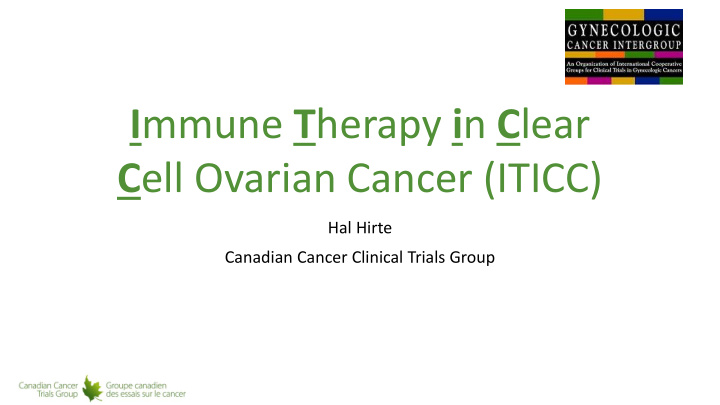



I mmune T herapy i n C lear C ell Ovarian Cancer (ITICC) Hal Hirte Canadian Cancer Clinical Trials Group
Results of Phase II Study of Durvalumab and Tremelimumab in recurrent clear cell ovarian cancer
Trial Schema Patients cohorts: This is a multi-centre, non-blinded, open-label single arm phase II study of durvalumab in combination with tremelimumab in patients with rare 1. Salivary carcinoma (excluding adenoid cystic carcinoma histology ) tumours. A minimum of 70, and a maximum of 140 patients will be 2. Carcinoma of unknown enrolled. primary with tumour infiltrating lymphocytes (TILs) and/or expressing PD-L1 TILs present and/or 3. Mucosal melanoma positive expression 2-stage design - Registration of PD-L1 each cohort 4. Acral melanoma for cohort 2 ONLY 5. Osteosarcoma 6. Undifferentiated pleomorphic sarcoma 7. Clear Cell Carcinoma of the Ovary 8. Squamous cell carcinoma of the anal canal (SCCA) 4
Clear Cell Ovarian Ca Results This arm has completed the 2 nd stage of accrual (20 patients total accrued) • • Responses seen in a number of patients on the clear cell arm to date • response data from stage II now available • We would accept the drug combination as active if four or more responses are observed from 20 patients accrued • This proposal is based on the clear cell ovarian ca arm demonstrating this level of activity • Anecdotally: • Significant responses are being seen • Some are particularly “deep” with marked tumour regression • Some appear to be durable • Have patients on therapy > 6 mo • Toxicity – as expected with this combination of agents
Response - Clear Cell Cohort • 20 eligible; 19 evaluable (1 symptomatic progression) • 7/20 pts had partial responses; duration 3.1-10.3m • 3/20 pts had stable disease as best response; duration 5.1- 6.9m • ORR = 35% (95% CI, 15.4% to 59.2%), 6
Next Steps Ovarian Cohort • AZ requested final analysis • To discuss expanding cohort further, evaluating single agent durvalumab or other combinations. • Will be discussed at a November 2018 meeting.
How can we build on this?
OCC is Chemoresistant CLEAR CELL CARCINOMA SEROUS CARCINOMA CR PR NC PD CR PR NC PD 7% 7% 4% 4% 18% 18% 7% 7% 45% 45% 9% 9% 82% 82% 28% 28% Sugiyama et al. Cancer 2000
Studies of PD-1/PD-L1 Inhibitors in OCC regimen men target phase se trial CTG G ID Durvalumab PD-L1 RCT II MOCCA NCT034054 vs chemo (N=46) (Singapore) 54 Nivolumab PD-L1 RCT II BrUOG354 NCT0335597 +/- ipilimumab +/- CTLA-4 (N=62) (Brown University) 6 Pembrolizumab PD-1 II NIH NCT036025 + epacadostat + IDO (N=23) (NRG-016) 86 Oda et al. Gynecol Oncol 2018 in press
IND228 – What next? • Next steps now that response data from stage II available? • Expand to a large single cohort study • Could be practice changing, but would need ~120 pts, and would require involvement of other GCIC partners. AZ has to be on board • Randomized phase 2/(3) compared to standard chemo • Cross over at progression on chemo? • Include other gynecologic clear cells cancers (endometrial, cervix)? • Interest in participation in such a trial?
Study Proposal • Comparison of durvalumab + tremelimumab, versus durvalumab alone versus standard of care chemotherapy in recurrent/metastatic clear cell of ovary (?and endometrium, cervix) • Study 1 - First line metastatic or recurrence with no prior chemotherapy – comparator is platinum-based chemo • Study 2 - Recurrence after previous chemotherapy – physicians choice of chemotherapy (carboplatin +/- paclitaxel/gemcitabine/PLD, weekly paclitaxel, liposomal doxorubicin, topotecan) • Up to 3 prior chemotherapy treatments • PS 0,1,2 • Normal marrow, kidney and liver function
Study Schema – First Line Trial First Line Chemotherapy Setting Previously untreated with metatastic or recurrent disease R Phase II stage Durvalumab + Platinum-based Durvalumab Tremelimumab chemotherapy Phase III Stage – continue accrual to best two arms and drop an experimental arm Phase III stage Patients on chemo control arm may cross-over to IO arm at progression
Study Schema – Previous chemotherapy Recurrence after first-line chemotherapy Up to 3 prior lines of chemotherapy R Phase II stage Durvalumab + Physician’s choice Durvalumab Tremelimumab chemotherapy Phase III Stage – continue accrual to best two arms and drop an experimental arm Phase III stage Patients on chemo control arm may cross-over to IO arm at progression
Study Endpoints • Toxicity/QOL • Response rate • Meaningful increase • from 10% in control arm to > 30% in IO arm for chemonaive • From 3% in control arm to > 20% in IO arm for previously treated • Increase in PFS by 50% • Increase in OS by 50% • Chemonaive • post carboplatin/paclitaxel PFS -10 mo, OS 21 mo • 50% increase in PFS from 10 to 15 mo, OS from 21 to 30 mo • Recurrence post chemo • PFS 8 mo, OS 18 mo • 50% increase in PFS from 8 to 12 mo, OS from 18 to 27 mo
Correlative studies • Will require baseline and on-study tumour biopsy • Optional biopsy at progression • Ongoing discussions about broad correlative biomarker analysis
Sample Size Estimate • Being reviewed with CCTG statistician
Feasibility • Interest from other GCIG partners? • Competing studies? • Timelines
Recommend
More recommend